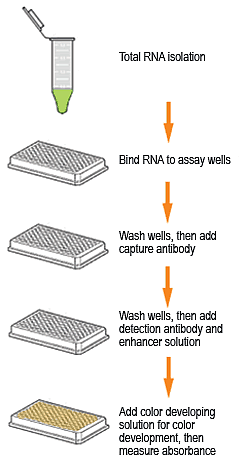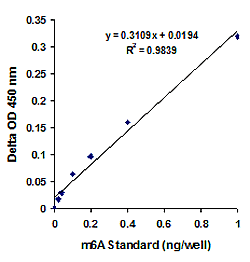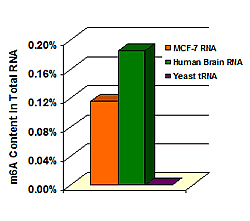EpiQuik m6A RNA Methylation Quantification Kit (Colorimetric)
Product Description
The EpiQuik™ m6A RNA Methylation Quantification Kit (Colorimetric) is a complete set of optimized buffers and reagents to colorimetrically quantify N6-methyladenosine (m6A) in RNA. It is suitable for a direct detection of m6A RNA methylation status using total RNA isolated from any species such as mammals, plants, fungi, bacteria, and viruses.
- Colorimetric ELISA-like assay using an m6A antibody with easy-to-follow steps.
- Entire procedure can be completed within 3 hours and 45 minutes.
- High sensitivity, of which the detection limit can be as low as 10 pg of m6A.
- Quantification of m6A from both mRNA and ncRNA such as tRNA, rRNA, and snRNA.
- Optimized antibody and enhancer solutions allow high specificity to m6A,
- No cross-reactivity to unmethylated adenosine within the indicated concentration range of the sample RNA.
- Universal positive and negative controls for quantifying m6A from any species.
- Strip-well microplate format for manual or high throughput analysis.
- Simple, reliable, and consistent assay conditions.
Background Information
N6-methyladenosine (m6A) is the most common and abundant modification in RNA molecules present in eukaryotes. The m6A modification is catalyzed by a methyltransferase complex METTL3 and removed by the recently discovered m6A RNA demethylases FTO and ALKBH5, which catalyze m6A demethylation in an α-ketoglutarate (α-KG)- and Fe2+-dependent manner. It was shown that METTL3, FTO, and ALKBH5 play important roles in many biological processes, ranging from development and metabolism to fertility. m6A accounts for more than 80% of all RNA base methylations and exists in various species. m6A is mainly distributed in mRNA and also occurs in non-coding RNA such as tRNA, rRNA, and snRNA. The relative abundance of m6A in mRNA transcripts has been shown to affect RNA metabolism processes such as splicing, nuclear export, translation ability and stability, and RNA transcription. Abnormal m6A methylation levels induced by defects in m6A RNA methylase and demethylase could lead to dysfunction of RNA and diseases. For example, abnormally low levels of m6A in target mRNAs due to increased FTO activity in patients with FTO mutations, through an as-yet undefined pathway, contributes to the onset of obesity and related diseases. The dynamic and reversible chemical m6A modification in RNA may also serve as a novel epigenetic marker of profound biological significance. Therefore, more useful information for a better understanding of m6A RNA methylation levels and distribution on RNA transcripts could benefit diagnostics and therapeutics of disease.
Principle and Procedure

Fig. 1. Schematic procedure of the EpiQuik™ m6A RNA Methylation Quantification Kit (Colorimetric)
In this assay, total RNA is bound to strip wells using a RNA high binding solution. N6-methyladenosine (m6A) is detected using a specific capture N6-methyladenosine antibody and detection antibody. The detected signal is enhanced and then quantified colorimetrically by reading the absorbance in a microplate spectrophotometer at a wavelength of 450 nm. The amount of m6A is proportional to the OD intensity measured. Both negative and positive RNA controls are provided in this kit. A standard curve can be performed (range: 0.02 to 1 ng of m6A) or a single quantity of m6A can be used as a positive control. Because m6A content can vary from tissue to tissue, and from normal and diseased states, or vary under treated and untreated conditions, it is advised to run replicate samples to ensure that the signal generated is validated. This kit will allow the user to quantify an absolute amount of m6A and determine the relative m6A RNA methylation states of two different RNA samples.
Performance Data

Fig. 2. m6A standard control was added into the assay wells at different concentrations and then measured with the EpiQuik™ m6A RNA Methylation Quantification Kit (Colorimetric).

Fig. 3. Quantification of m6A RNA methylation in different samples. 200 ng of RNA isolated from different tissues or cells were added into the assay wells and the m6A contained in RNA was measured using the EpiQuik™ m6A RNA Methylation Quantification Kit
Starting Materials
Starting materials can include various tissue or cell samples such as cells from flask or microplate cultured cells, fresh and frozen tissues, paraffin-embedded tissues, blood, body fluid samples, etc.
Product Citations
- Angelin M, Gopinath P, Raghavan V, Thara R, Ahmad F, Munirajan AK, Sudesh R (2024) Global DNA and RNA Methylation Signature in Response to Antipsychotic Treatment in First-Episode Schizophrenia Patients. Neuropsychiatr Dis Treat
- Bai Y, Chang D, Ren H, Ju M, Wang Y, Chen B, Li H, Liu X, Li D, Huo X, Guo X, Tong M, Tan Y, Yao H, Han B (2024) Engagement of N(6)-methyladenisine methylation of Gng4 mRNA in astrocyte dysfunction regulated by CircHECW2. Acta Pharm Sin B
- Benak D, Holzerova K, Hrdlicka J, Kolar F, Olsen M, Karelson M, Hlavackova M (2024) Epitranscriptomic regulation in fasting hearts: implications for cardiac health. RNA Biol
- Broca-Brisson L, Disdier C, Harati R, Hamoudi R, Mabondzo A (2024) Epigenetic alterations in creatine transporter deficiency: a new marker for dodecyl creatine ester therapeutic efficacy monitoring. Front Neurosci
- Bussey-Sutton CR, Ward A, Fox JA, Turner AW, Peterson JJ, Emery A, Longoria AR, Gomez-Martinez I, Jones C, Hepperla A, Margolis DM, Strahl BD, Browne EP (2024) The histone methyltransferase SETD2 regulates HIV expression and latency. PLoS Pathog
You save 10 %
500,00 €
